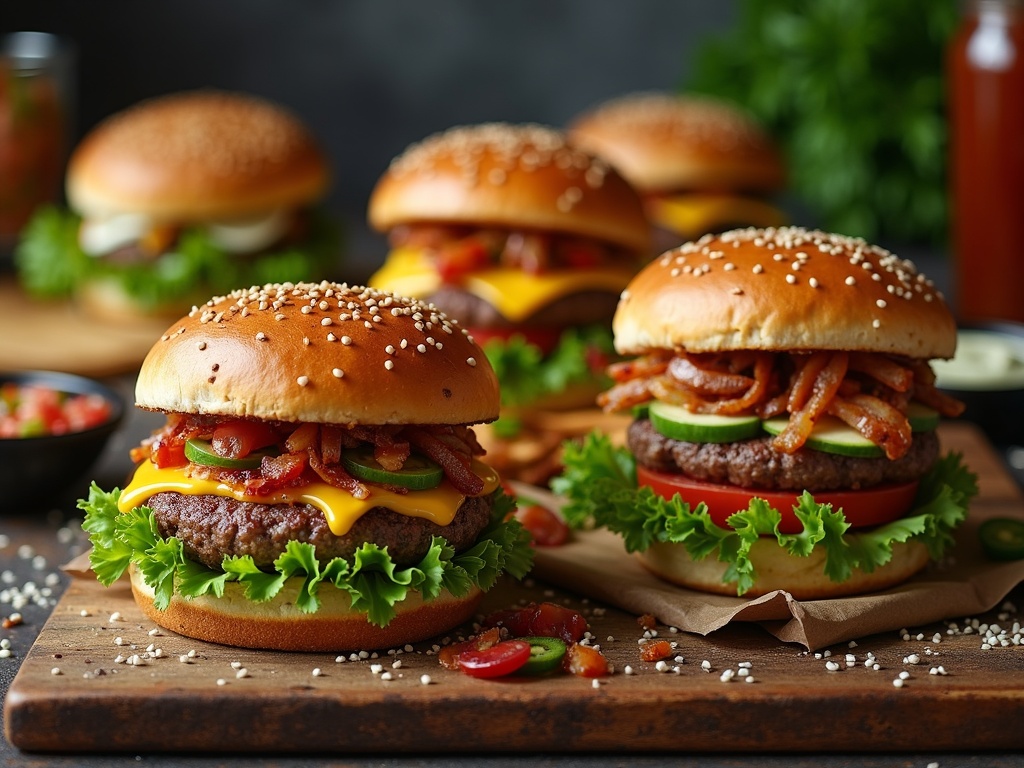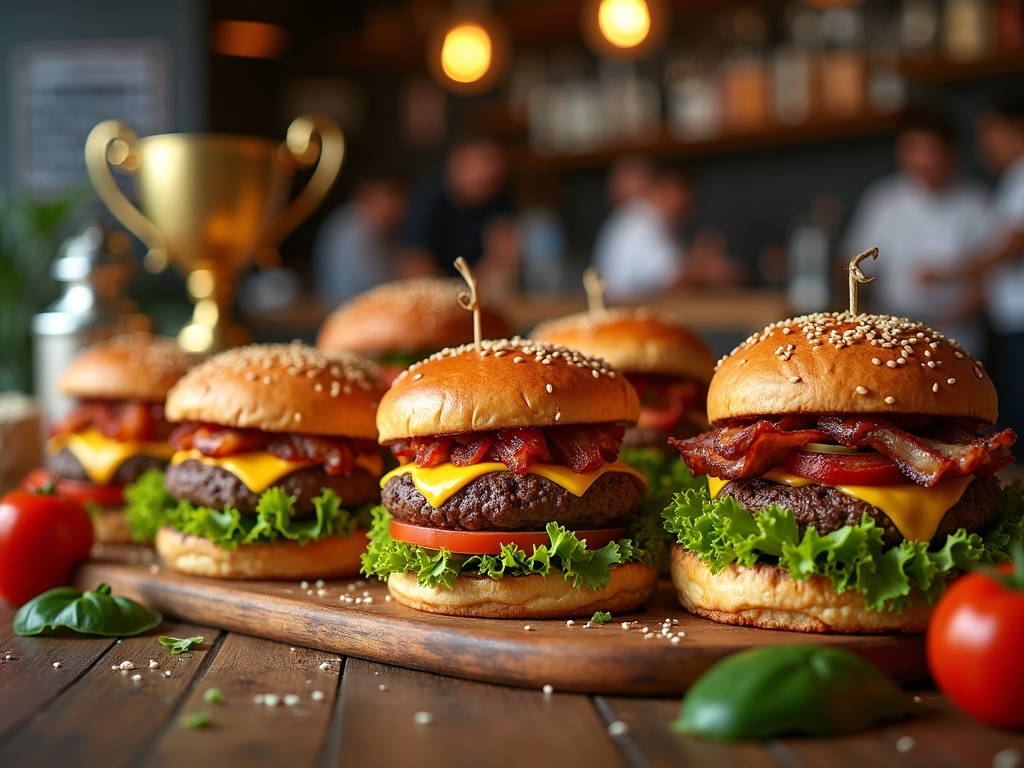The burger industry has exploded into a global market valued at $100 billion in 2021, with expectations to reach $138 billion by 2026 at a 6.2% annual growth rate. Americans consume approximately 50 billion burgers annually—averaging three burgers weekly per person—which has transformed this simple sandwich from fast food staple into a culinary canvas for creative expression across home kitchens and professional establishments alike.
Find In This Article
Key Takeaways
- The global burger market is projected to grow from $100 billion to $138 billion by 2026, representing a significant economic force in the food industry.
- Plant-based burger alternatives are gaining substantial market share, with the veggie burger segment projected to grow 11.6% between 2021-2028.
- The average American consumes about three burgers weekly, contributing to the national consumption of 50 billion burgers annually.
- Burgers have evolved from simple fast food to cultural icons with dedicated holidays (National Burger Day, National Cheeseburger Day) and significant media representation.
- Health-conscious consumers are increasingly turning to alternative protein sources like turkey, chicken, and plant-based patties that offer lower calorie and fat content.
The Booming Billion-Dollar Burger Business
The burger industry isn’t just big—it’s massive. Currently valued at $100 billion in 2021, the global burger market is expected to sizzle its way to $138 billion by 2026. That’s a mouth-watering 6.2% compound annual growth rate that has investors and restaurant owners alike paying close attention to this juicy market segment.
America’s Burger Obsession
My fascination with burgers isn’t unique—Americans collectively devour approximately 50 billion burgers annually. Breaking that down, the average American consumes about three burgers every week. This impressive consumption rate explains why homemade burgers have become such a staple in home cooking across the country. The burger has transformed from a simple fast-food item to a culinary canvas where both professional chefs and home cooks can express their creativity.
The popularity has sparked countless variations, from basic beef patties to gourmet creations with premium toppings. Learning how to cook ground beef properly has become an essential kitchen skill for many Americans looking to recreate their favorite burger experience at home.
Beyond Traditional Consumption
The burger’s cultural impact extends beyond just eating them—it’s created entire subcultures and competitions. Take speed-eating contests, for example. The competitive speed-eating record for consuming a burger stands at an incredible 3.43 seconds, set by Hirofumi Nakajima in 2019. This kind of extreme competition highlights just how deeply burgers have been integrated into modern food culture.
The smash burger recipe trend has also taken the culinary world by storm in recent years. This technique, which involves pressing a ball of ground beef onto a hot cooking surface, creates a burger with crispy, caramelized edges while maintaining a juicy center. It’s just one example of how burger preparation continues to evolve despite the food’s long history.
The economic impact of burgers goes beyond restaurant sales. This humble sandwich supports vast supply chains including beef producers, bun manufacturers, vegetable farmers, and condiment makers. With plant-based alternatives now gaining significant market share, the burger economy continues to expand in new directions, confirming that this iconic food item shows no signs of losing its place in global food culture.
Plant-Based Revolution Meets Classic Favorites
The burger landscape is experiencing a major shift as plant-based options gain substantial market share. Veggie burger segments are projected to grow 11.6% between 2021-2028, reflecting changing consumer preferences toward more sustainable and health-conscious choices. Despite this evolution, traditional burger styles continue to hold their ground with unique twists that keep customers coming back for more.
Evolving Burger Styles and Premium Trends
Classic favorites remain popular while adapting to modern tastes. I’ve noticed that homemade burgers often incorporate elements from these established styles:
- Classic cheeseburgers: The timeless combination of beef patty, melted cheese, and fresh toppings continues to be the foundation of burger culture.
- Turkey burgers: A leaner alternative that’s gained popularity for its health benefits while still delivering satisfying flavor.
- Gourmet burgers: Elevated versions featuring unique ingredient combinations and cooking techniques like the smash burger recipe that creates a perfect crust.
- Plant-based options: Beyond simple veggie patties, these now mimic the texture and flavor of beef with impressive accuracy.
The premium burger movement has introduced ingredients that were once considered fancy restaurant fare. Truffle aioli adds earthy complexity, while bacon jam provides sweet-savory depth that transforms an ordinary burger into something special. Blue cheese crumbles bring tangy richness that pairs perfectly with properly cooked ground beef patties.
Major chains have played a significant role in defining regional burger styles. Shake Shack popularized the smashed patty with its signature potato bun and special sauce. In-N-Out Burger created cult-like devotion with its fresh-never-frozen approach and not-so-secret menu. Five Guys established itself with customizable toppings and hand-cut fries that complement their juicy burgers.
These influences have trickled down to home kitchens where burger enthusiasts are mixing and matching elements from different styles. The beauty of today’s burger scene is the freedom to blend traditional techniques with innovative ingredients—creating personalized versions that satisfy both nostalgia and adventure on a single bun.

From Street Food to Cultural Icon
The humble burger has traveled an extraordinary journey from simple street food to becoming a defining culinary symbol across the globe. I’ve watched with fascination as this handheld delight transformed from a practical meal solution into something that inspires dedicated holidays, media franchises, and high-end dining experiences.
The Birth of an American Classic
The burger’s exact origins remain hotly contested, but many food historians trace it back to the late 19th century. One of the most celebrated origin stories belongs to Louis Lassen, who in 1885 reportedly created the first hamburger sandwich at his New Haven, Connecticut lunch wagon. As the story goes, Lassen served ground beef between two slices of toast to a customer in a hurry who needed a meal he could eat on the go. This practical solution to portable dining would eventually spark a culinary revolution that changed how the world eats.
The hamburger’s rise coincided perfectly with America’s increasing pace of life, offering a convenient, satisfying meal that could be consumed quickly. This practicality helped the burger transition from novelty to necessity in American food culture. Today, making homemade burgers remains one of the most satisfying cooking experiences for both beginners and experienced cooks alike.
What’s fascinating is how this simple sandwich has been elevated to cultural icon status, complete with its own holidays. National Burger Day on May 28th and National Cheeseburger Day on September 18th have become legitimate food celebrations where restaurants offer special promotions and social media lights up with burger appreciation posts.
Popular media has played a significant role in cementing the burger’s cultural significance. Who can forget the famous “Royale with Cheese” conversation in “Pulp Fiction,” where characters discuss how McDonald’s names their quarter pounder in France? The animated series “Bob’s Burgers” centers entirely around a family-run burger restaurant, featuring creatively named burgers in each episode. These media representations don’t just reflect our love for burgers – they actively reinforce and expand it.
Perhaps the most telling sign of the burger’s cultural evolution is the rise of gourmet burger establishments. Chains like Umami Burger and standalone restaurants like The Burger Joint have transformed the humble hamburger into an artisanal experience. These upscale versions feature carefully sourced ingredients, custom blends of meat (or plant alternatives), and house-made condiments that elevate the burger to fine dining status.
The smash burger recipe trend represents yet another evolution, showing how even basic cooking techniques can be refined and celebrated. The method of smashing a ball of ground beef onto a hot griddle creates a crust that many burger enthusiasts consider superior to traditional cooking methods.
What makes the burger’s story so compelling is its democratic nature. From fast food value menus to $50 wagyu creations, there’s a burger for every budget and preference. Learning how to cook ground beef properly is often one of the first skills new cooks master, making burger preparation an entry point to cooking for many people.
The burger sits at a unique crossroads in food culture – it’s simultaneously everyday fare and special occasion splurge, depending on the context. It’s a canvas for culinary creativity yet remains recognizable even in its most innovative forms. This versatility has allowed the burger to transcend its humble origins and become not just a meal but a cultural touchstone that connects people across generations, geography, and social strata.

The Health Equation
I’ve noticed a significant shift in how people approach burger consumption these days. Health consciousness has transformed the humble burger from a guilty pleasure into something that can actually fit into a balanced diet. The calorie content varies widely depending on your choice of patty, and understanding these differences can help you make smarter choices.
Calorie Breakdown by Burger Type
A standard hamburger with a 4 oz beef patty typically contains between 250-300 calories before any toppings or condiments. That’s just the patty alone! Once you start adding cheese, special sauces, and a bun, that number can easily double.
For those looking to reduce their calorie intake, vegetarian burger options present an appealing alternative. Most plant-based patties average between 150-250 calories, offering a notable reduction compared to their beef counterparts. This calorie difference becomes even more significant when you’re enjoying burgers regularly.
The health equation doesn’t stop at calories though. Many people are now factoring in other nutritional aspects when choosing their burger base. I’ve found that homemade burgers allow for complete control over ingredients, making them an excellent choice for health-conscious eaters.
Shifting Preferences in Protein Sources
The rising health consciousness isn’t just changing what’s in our burgers but fundamentally altering which proteins we’re selecting. Research linking excessive red meat consumption to various health concerns has prompted many to seek alternatives.
Poultry options have gained significant popularity in recent years. Chicken and turkey burgers typically offer:
- Lower fat content than beef
- Reduced calorie count
- Similar protein levels
- Less saturated fat
- Lighter environmental footprint
I’ve personally found that properly cooked ground meat of any variety makes all the difference in creating a satisfying burger experience. The cooking technique can significantly impact both taste and nutritional profile.
Beyond poultry, plant-based alternatives have evolved dramatically. No longer just for vegetarians, these options appeal to flexitarians and meat-eaters looking to reduce their red meat intake. Modern plant-based patties mimic the texture and flavor of beef while delivering better nutritional stats.
The smash burger technique has also gained popularity among health-conscious eaters. By using a smaller amount of meat but maximizing surface area and flavor through smashing, you can enjoy a satisfying burger experience with less overall meat.
The burger landscape continues to evolve with health-focused innovations. From blended patties (combining meat with mushrooms or other vegetables) to alternative grain buns and creative vegetable toppings, the modern burger can be customized to fit virtually any dietary preference or restriction.
I’ve found that thinking about burgers through this health equation lens doesn’t diminish the enjoyment—it actually enhances it. There’s something deeply satisfying about enjoying a delicious burger that aligns with your nutritional goals rather than working against them.
Sources:
Statista, “Global Burger Market Size”
Food Institute, “U.S. Burger Consumption Statistics”
National Institute of Health, “Health Effects of Red Meat”
International Journal of Gastronomy, “Gourmet Burger Trends”
Food Network, “Burgers in Movies and Television”

